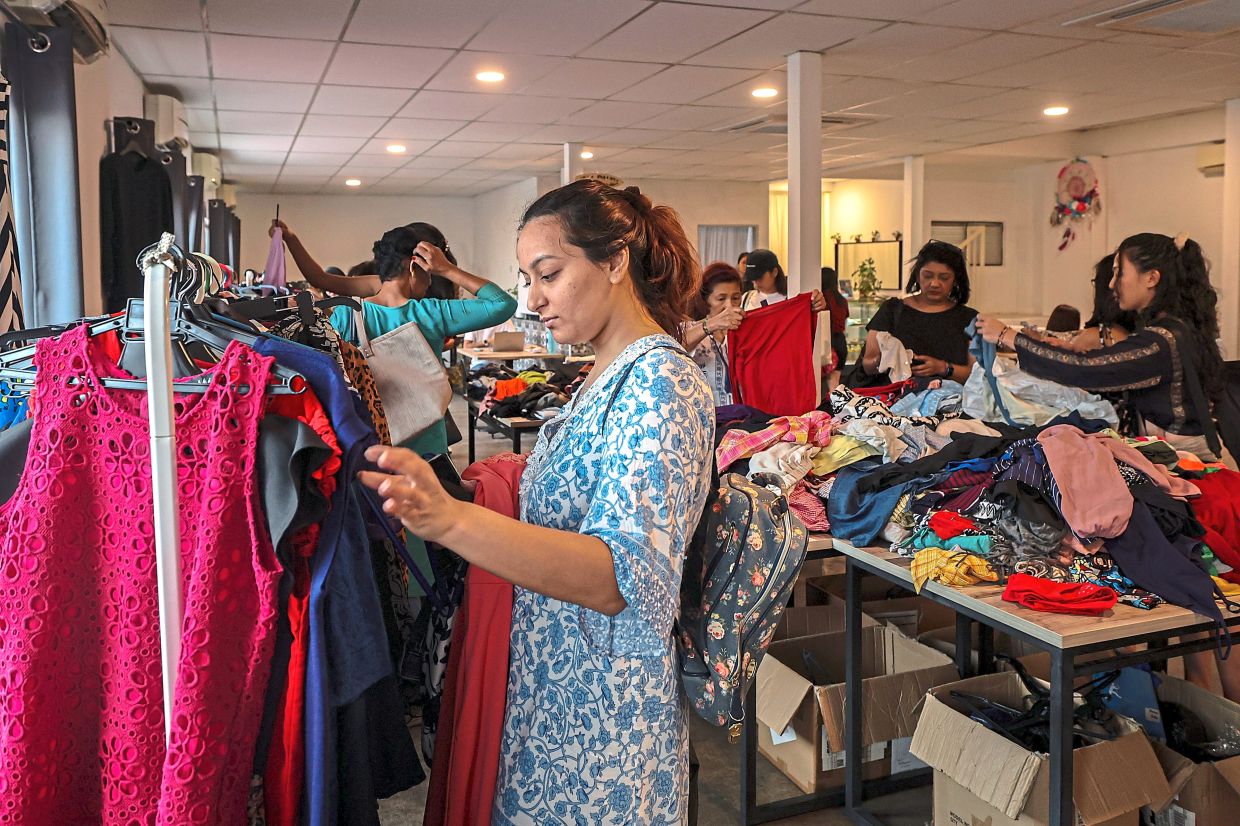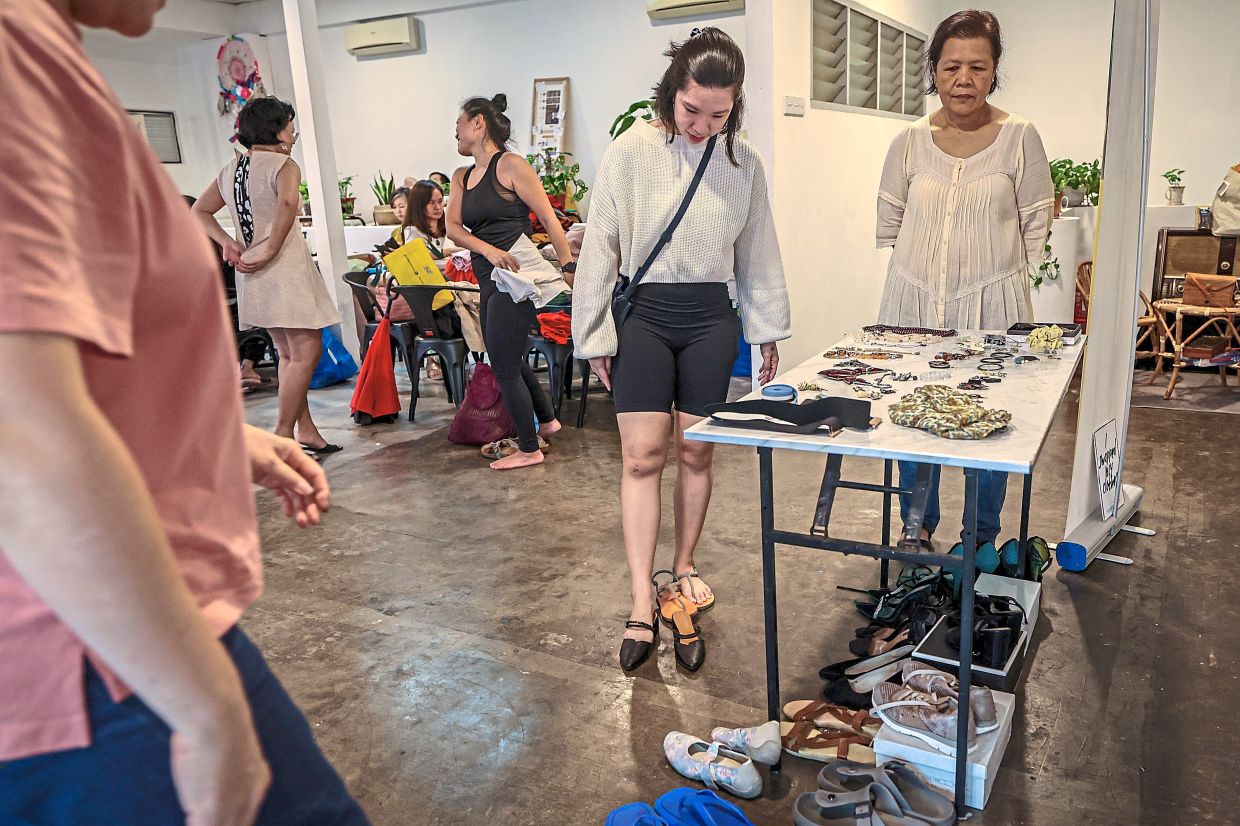Sustainable fashion: A customer browsing through the clothes available at a Project Swap event, which is organised about six to seven times a year. — Bernama
Event allows visitors a chance to swap apparel, accessories and reduce clothing waste sent to landfills at the same time
IN A cafe located above a convenience store in Petaling Jaya, Selangor a chalkboard emblazoned with the words “The Swap Project” points to the event the place is hosting, which has little to do with coffee.
Inside, clothes are piled on tables, jackets, coats and fancy tops hang on clothes racks while formal-looking dresses are neatly placed by the windows.
Off to one side is an accessories table showcasing costume jewellery and shoes.
People can be seen perusing what’s available and pulling out pieces they like.
A stream of women enter and exit every few minutes, many carrying a big bag full of clothes.
Towards the back of the cafe, a group of volunteers sort newly arrived clothes and help customers take away their newfound items.
Most of the customers are urbanites in their 20s and 30s, armed with good intentions, a love of clothes and a nose for bargains.
For all intents and purposes, the event may look like a jumble sale.
But to The Swap Project founder Jayda Chong, the moniker doesn’t exactly fit, as the focus is more on exchanging items versus buying them.
Once swapped, new owners have an option to come back and exchange the clothes for another item.
“This place offers a new kind of shopping experience,” said software programmer Mandy How.
While it was her second time at The Swap Project event, her mother Eoi Leng Lai had attended five similar occasions.
Like many other people here, How cited the environment as the primary driver for participating in the event.
Concerned about Malaysia’s throwaway culture and intent on reducing fashion waste, a burgeoning environmental disaster, Chong founded The Swap Project in 2018 as a way to keep clothes circulating longer.
“All of these clothes would have otherwise ended up in a landfill,” she said.
According to Solid Waste Management and Public Cleansing Corporation (SWCorp) and KlothCares, 31% or 432,901 tonnes of total waste generated in Malaysia in 2021 was fabric waste.
The United Nations reported that the world produced an estimated 100 billion garments each year, of which 92 million tonnes end up in landfills.
At least 7% of landfills comprise discarded clothing and textiles. About 1% of clothing is recycled.
To make matters worse, most of the fabrics nowadays, produced via fast fashion - clothing designs that move quickly from the catwalk to stores to take advantage of trends - are made from synthetic fibres, namely fossil fuels.
It means that just like plastic, once these clothes are thrown out, they will not decay and will instead contribute to global warming.
This year’s weather has been marked as the hottest on record since 1940.
Scientists say the world is at a tipping point as the earth gets warmer.
The Swap Project hopes to put a dent in climate change, no matter how little, by reducing the amount of fashion waste going into landfills.
People behind the project encouraged the public to exchange their good quality but no longer used clothes, for whatever reason, with someone else’s items.
There is a cover charge of RM50, which goes to pay operational and venue costs.
Everyone is entitled to take home 15 items – be they clothes, shoes or jewellery.
“The most satisfying part of the swap was giving my clothes to other people, because I have so many pieces that I am reluctant to throw away.
“I didn’t think they were old enough to be recycled,” said Victoria Lee, a business owner.
Normalising swapping
Since its inception, the group has held 28 events, or about six or seven per year, albeit fewer during the Covid-19 pandemic years.
The Swap Project is not the only clothes-swapping initiative in Malaysia.
It has worked with a similar group in Malaysia, namely the Fashion Revolution by influencer Melissa Tan.
To date, the group has managed to swap between 6,000 and 7,000 pieces of clothing.
“Not a lot of people know about (us). Definitely not enough,” said Chong, adding that the group is still working on spreading the word.
The pandemic restrictions from 2020 to 2022 did not help. Things have improved since, with more people attending each swap.
All of the customers interviewed cited the importance of sustainability as their reason for attending the swaps.
Others cited the fun of bargain hunting and searching for fashion gems, as well as knowing that whatever item they got were most likely one-of-a-kind.
Lee, who came to the event with her friend Faustina Gui, said that clothes-swapping had helped her buy less while keeping her fashion needs satisfied.
“It’s something I’m trying to unlearn in my life. I was the sort of person who would go to a sale and have to get something, no matter what,” she said.
Lee said she had been able to find something that suited her style each time she attended a swap. But not everyone is as lucky.
There are several issues The Swap Project has to contend with.
For one, there is a limit on choices. People of non-average sizes tend to be out of luck when looking to swap clothes in a style they favour.
First-timer Margaret Gunasegran, found only two items she liked that fit her.
The accounts manager at a computer company went with her colleague and friend Hesti Kurniawaty.
Despite her disappointing haul, Margaret has planned to return to future events to try her luck.
“I can get something in a size that I want (here), because there are US or European sizes, which are not usually available in the (Malaysian) market,” she said, adding that the low cover charge meant whatever she got from the swap event was already a bargain.
“It’s satisfying because I’m not wasting money unnecessarily,” she said.
Gender is another issue. Most of the patrons are women, which means most items cater to them.
There were a few men huddled together in one corner of the cafe.
Most were partners or family members of the women there. None participated although a few indicated their interest.
Chong acknowledged the limitations and said she was working on increasing the inventory, size and style choices, to give patrons more options.
She may also hold men-only swapping events.
“If more people participate, then there’s definitely more choices available,” she said.
One issue that looms large is public misconception of clothes swapping and what it meant.
Mother and daughter Komala and Mishall Nair love clothes swapping but noted it was still a niche market in Malaysia.
Komala said many, especially the older generation, equate purchasing new items with status.
“They think ‘Why take other people’s clothes? We are not poor’”
“But I have learned to change my mindset through social media and my children,” she said.
Mishall, who works with the Securities Commission, acknowledged some people may be apprehensive about swapping.
She has tried to spread the word and encourage people to attend clothes-swapping events, but there are not many takers.
“Some people would rather buy used clothes online.
“They think, ‘What if I don’t get what I want? At least if I’m buying, I know what I’m getting instead of coming here with my good clothes to swap,’” she said.
Mishall thinks sustainable practices are growing in popularity and will likely be more common in future, as long as people continue to increase awareness and spread the message as much as possible.
“Clothes are filling up landfills. I feel the younger generation are more exposed to this practice so there is now a larger group of Malaysians who are pushing for sustainable practices,” she said. — Bernama












